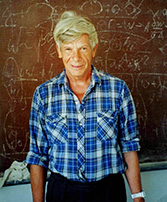Speaker
Description
In [1]-[5] we developed the theory of spinors on the basis of the superalgebraic representation. In it, spinor field operators are constructed from Grassmann densities in the momentum space and derivatives with respect to them. We have shown that generators of transformations that preserve the CAR algebra of spinor creation and annihilation operators are analogs of Dirac gamma matrices and can be constructed from Grassmann densities and their derivatives [1]-[3]. But, in contrast to the Dirac theory and its generalization within the framework of the second quantization method, in addition to the five usual Dirac gamma matrices, two additional gamma operators (basis Clifford vectors) appear in the theory of superalgebraic spinors [2]. In the matrix representation, they correspond to two additional gamma matrices. The generator of rotation in the plane of these vectors in the simplest case of four basis Grassmann densities is the operator of the electric charge of the spinor [4]. Using the superalgebraic representation, we were able to explicitly construct the state vector of the spinor vacuum [1], and also prove that the symmetries T and C transform this vacuum into an alternative one, which is why they cannot be exact symmetries of our Universe [4]-[5].
However, the main issue in the developed theory was the correspondence of the superalgebraic representation to the standard QFT. In this article, we have solved this issue. Instead of considering the superalgebraic representation of spinors, we have considered all possible transformations of the connected Lie group of spinor creation and annihilation operators that preserve their CAR algebra. We have shown that in the case of a four-component spinor, these transformations are generated by the seven gamma operators we obtained earlier, the corresponding Lorentz transformations, as well as the gauge transformations of the electromagnetic field associated with rotation in the plane of the sixth and seventh gamma operators (Clifford vectors). We discuss the limitations of no-go theorems on possible transformations of the Lie group of spinors, including in the presence of a multiplet of two spinors (an eight-component spinor) or more than four spacetime dimensions.
- Monakhov V.V. Superalgebraic structure of Lorentz transformations. J. Phys.: Conf. Ser. 2017, 1051, 012023.
- Monakhov V.V. Generalization of Dirac Conjugation in the Superalgebraic Theory of Spinors. Theor. Math. Phys. 2019, 200, 1026–1042.
- Monakhov V. Vacuum and Spacetime Signature in the Theory of Superalgebraic Spinors. Universe 2019, 5, 162.
- Monakhov V.V. The Dirac Sea, T and C Symmetry Breaking, and the Spinor Vacuum of the Universe. Universe 2021, 7(5), 124.
- Monakhov V.V., Kozhedub A.V. Algebra of Superalgebraic Spinors as Algebra of Second Quantization of Fermions. Geom. Integrability & Quantization, 2021, 22, 1652021.

